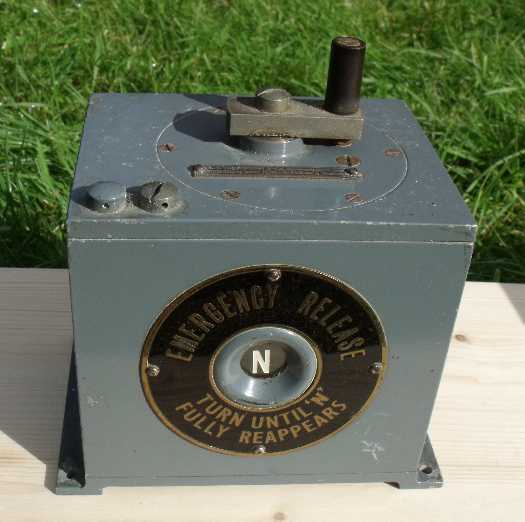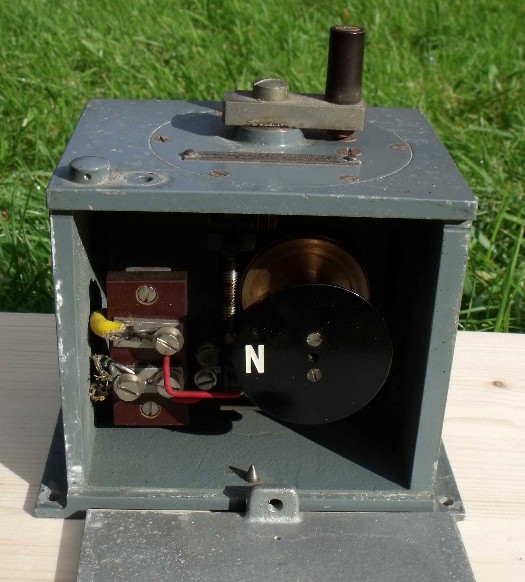Welwyn release (manual time release)
An interesting feature of Welwyn control was the need to be able to 'reset' or 'release' it - for example if the train was signalled but then cancelled. Since the release could have dangerous consequences if used incorrectly, it was desirable to ensure that the system could not be released in too casual a fashion.
The method the LNER chose was to use the devices shown below (click on image for larger view). To operate the release, it is necessary to wind the handle until the N reappears in the window. This takes around 2 minutes, which is supposed to be long enough to make one think if one is doing something unsafe. It is interesting to compare this with the release methods used with Midland Railway Rotary block, which comprised a glass breakseal, or a cooperative plunger which had to be operated by two signalmen simulataneously. Basically, these are reset devices for a situation where incorrect use could
have dangerous consequences, and were (and are) used for other applications
besides Welwyn block control. 'Manual time release' would be a better name for them.
LNER releases seem to have been rectangular like those illustrated. The grey ones have an
R E Thompson makers plate. R E Thompson and Co also seem to have made some of the earliest
block instruments to be fitted with Welwyn control - was that a coincidence?
Perhaps not!
Although some are made of brass and some of aluminium, they are electrically identical inside.
They have two sets of contacts. This device is shown in the normal position:
Basically, these are reset devices for a situation where incorrect use could
have dangerous consequences, and were (and are) used for other applications
besides Welwyn block control. 'Manual time release' would be a better name for them.
LNER releases seem to have been rectangular like those illustrated. The grey ones have an
R E Thompson makers plate. R E Thompson and Co also seem to have made some of the earliest
block instruments to be fitted with Welwyn control - was that a coincidence?
Perhaps not!
Although some are made of brass and some of aluminium, they are electrically identical inside.
They have two sets of contacts. This device is shown in the normal position:
 Richard Pike has sent me this BR diagram
showing the construction of the device (113 kB).
The sequence of operation is as follows:
Normal position - N - normal contacts closed.
start winding. N contacts open.
keep winding... and winding ... and winding ...
Reverse position - R - reverse contacts close.
On some, but not all, devices an R appears in the window at
this point.
keep winding, R contacts open.
soon afterwards...
Normal position again, N contacts close.
There is, however, one small puzzle. The first Welwyn control circuit (circuit 1A, original form)
only required
one set of contacts to be closed to release it. So why do most Thompson releases have
two sets of contacts?
Or, is there an early type of Welwyn release which had only one set?
Unusual Welwyn Release (Manual Time Release)
Here is a slightly different release, also made by Thompson and Co.
Richard Pike has sent me this BR diagram
showing the construction of the device (113 kB).
The sequence of operation is as follows:
Normal position - N - normal contacts closed.
start winding. N contacts open.
keep winding... and winding ... and winding ...
Reverse position - R - reverse contacts close.
On some, but not all, devices an R appears in the window at
this point.
keep winding, R contacts open.
soon afterwards...
Normal position again, N contacts close.
There is, however, one small puzzle. The first Welwyn control circuit (circuit 1A, original form)
only required
one set of contacts to be closed to release it. So why do most Thompson releases have
two sets of contacts?
Or, is there an early type of Welwyn release which had only one set?
Unusual Welwyn Release (Manual Time Release)
Here is a slightly different release, also made by Thompson and Co.
 Not only is the winding handle on top, it only has one set of contacts:
Not only is the winding handle on top, it only has one set of contacts:
 The device can be configured (by moving one of the red wires) so that in the N position
the contacts are either open or closed. In its present state the contacts are normally closed
(which is not actually consistent with its use as release for Circuit 1A).
The device can be configured (by moving one of the red wires) so that in the N position
the contacts are either open or closed. In its present state the contacts are normally closed
(which is not actually consistent with its use as release for Circuit 1A).